A Progress Check: The Small Successes Of Nanotech
And a look at NNI, a seeming success story in govt funding
My budget supports a major new national nanotechnology initiative worth $500 million. Caltech is no stranger to the idea of nanotechnology, the ability to manipulate matter at the atomic and molecular level. Over 40 years ago, Caltech's own Richard Symonds asked, what would happen if we could arrange the atoms one by one the way we want them? Well, you can see one example of this in this sign behind me, that Dr. Lane furnished for Caltech to hang as the backdrop for this speech. It's the Western hemisphere in gold atoms. But I think you will find more enduring uses for nanotechnology.
President Bill Clinton, January 21 2000, Caltech
[Epistemic status: Wildly out of my depth, but reasonably sure on progress that already happened. Highly interested in thoughts and opinions on what’s next here.]
2021 is ending. It probably wasn’t the happiest year of most of your lives. So, welcome to a happy story. Happier, anyway. I'd like to talk about one of the tiny tiny government agencies which has had rather remarkable success, with limited resources and with but tiny amounts of attention. I'm talking about the National Nanotechnology Initiative.
Perhaps the biggest leap, and source of inspiration, in science not that long ago was nanotechnology. A large part of the obsession around it started from Prof Feynman and his incredible lecture, There's Plenty of Room At The Bottom. It captured the imagination of pretty much every science fiction author and most scientists since then.
But in many ways its seen as somewhat of a sideshow. As something that once seemed interesting but had to be laid aside on the wayside. It's also highly interdisciplinary by necessity, mixing physics, chemistry and recently biology to make advances.
And topical, in that the lipid nanoparticles have been pretty helpful in getting mRNA vaccines into us.
President Bill Clinton advocated for funding of research in this emerging technology during a speech at Caltech on January 21, 2000. Three years later, President George W. Bush signed into law the 21st Century Nanotechnology Research and Development Act. The legislation made nanotechnology research a national priority and created the National Technology Initiative.
The National Nanotechnology Initiative (NNI) in the United States define Nanotechnology as “a science, engineering, and technology conducted at the nanoscale (1 to 100 nm), where unique phenomena enable novel applications in a wide range of fields, from chemistry, physics and biology, to medicine, engineering and electronics
In a timeframe of approximately half a century, nanotechnology has become the foundation for remarkable industrial applications and exponential growth. For example, in the pharmaceutical communities of practice, nanotechnology has had a profound impact on medical devices such as diagnostic biosensors, drug delivery systems, and imaging probes. In the food and cosmetics industries, use of nanomaterials has increased dramatically for improvements in production, packaging, shelf life, and bioavailability. Zinc oxide quantum dot nanoparticles show antimicrobial activity against food-borne bacteria, and nanoparticles are now used as food sensors for detecting the food quality and safety.
In general it seems you can build nanostructures in two ways:
Top down, starting with something bigger and breaking it down
Bottom up, starting with a bunch of atoms and molecules and layering them up
The top down approach is mainly done by precision engineering and lithography, and bottom up by chemical synthesis primarily. We’ve done some of both.
The research started in great stead since Feynman's lecture.
There was a progress in nanotechnology since the early ideas of Feynman until 1981 when the physicists Gerd Binnig and Heinrich Rohrer invented a new type of microscope at IBM Zurich Research Laboratory, the Scanning Tunneling Microscope
They etched IBM on a nickel substrate, and despite that got the Nobel Prize in Physics. Their work also went towards inventing the atomic force microscope and scanning probe microscopes, used widely today!
Its also maybe the best example of a field that grew combinatorially, finding its way to meld with every large domain out there.
NNI
The NNI was set up to coordinate work between twenty agencies, and has had its budget increased over multiple administrations. It tries to bring together the work from its participating agencies to push the technology forward. The NNI is coordinated by the Nanoscale Science, Engineering, and Technology (NSET) - a subcommittee of the National Science and Technology Council's (NSTC) Committee on Technology, under the White House Office of Science and Technology Policy.
The funding is split amongst the agencies who actually run the initiatives. In 2020, NNI had a budget of $1.4B, which is tiny in the scheme of things!
In the history of NNI, from their budget supplement, we can see:
While advances in modern electronics have long been at the nanoscale, new nanomaterials and designs will ensure the continued strength of the U.S. semiconductor industry, which powers computing, e-commerce, and national security. Nanotechnology also enables the rapid genomic sequencing and sensing required to advance medicine and biotechnology. Nanotechnology R&D has enabled early detection of emerging diseases and will lead to the treatments of the future. Past investments in nanotechnology research and development have provided a foundation to support the response to the COVID-19 pandemic. Nanotechnology-enabled applications include vaccines, sensors, masks, filters, and antimicrobial coatings.
The "bringing together" part of NNI's mandate seems to have been an unqualified success.
the activities of the NNI have translated into the creation of excellence networks and centres in the US, such as the National Nanomanufacturing Network (NNN, https://www.internano.org/nnn) the Center for Sustainable Nanotechnology (CSN, https://susnano.wisc.edu), the National Nanotechnology Coordination Infrastructure (https://www.nnci.net) and the Nanosystems Engineering Research Center for Nanotechnology-Enabled Water Treatment (NEWT, https://www.newtcenter.org).
The quadrennial review showers NNI in bureaucratic hedge speak minor praise, with an admonishment to do more to do more so US doesn’t lose its place as the global leader. But even with that, it reads like an analyst trying hard to write “can do better” on a performance review.
Areas of success
A bunch of these I had never even heard of! Let's take 10 of the cooler ones to start with.
A bunch of NIH researchers eliminated, for the first time, replication-competent HIV-1 DNA from the genomes of living animals. They put a modified antiretroviral drug, packaged into nanocrystals, to distribute to the tissue where the HIV was.
Quantum devices were fabricated by DOE and NIST with near atomic precision, using clusters of phosphorous atoms as donor dopants placed in sillicon.
NSF developed a model to predict the adsorption of any metallic nanoparticle, using computational chemistry and machine learning.
Nanosensors were used by FDA to develop novel diagnostic assays for HIV, dengue, flu, Zika
NIST with NIH have demonstrated biosensors which can have precise measurements of enzymes that might cause Alzheimers, Parkinsons and some brain cancers
NIST measured the thermodynamics of the essential building block of DNA origami, a single fold, as well as the relative yield of that single fold
ARS developed a method for rapid detection of pathogens in fresh fruit and fish
Speeding up wound healing through new type of adhesive hydrogels, by NIH folks
Figuring out a way to create high energy density batteries with a new cathode, made of nanostructured selenium-carbon composite, by DOE
Last, but not least, designing vaccines for cancer immunotherapies by DOD and NIH!
There's at least 25 more insanely cool items listed in the budget supplement, feel free to go and read. Despite its incredibly boring writing, what they're talking about reads like science fiction. Even if only a fraction of the research gets commercialised in the coming decade, it'll be a leap forward.
And where they’re tried, the results are amazing! If there was a case for science fiction come to life, it would be this, enabling things like luminescent nanoparticles to track temperature changes in brain surgery. Because they are incredibly small, a substantial proportion of the material is externally exposed (are on the surface rather than the interior). And they have much fewer direct neighbours and hence contain unsaturated bonds. This means that there's much higher reactivity, which makes them ideal for all sorts of applications. Quoting from Nanowerk:
Nanoscale metal oxides such as titanium dioxide (TiO2) and zinc oxide (ZnO) are already used on a larger scale in consumer goods such as cosmetics, paints and varnish. Zircon (ZrO2) and aluminium oxide (Al2O3) nanopowders are used as components in technical ceramics to improve both hardness and breaking strength.
And they're applied across a wide variety of industries. In life sciences, they're used for biochips and markers. In cosmetic products and sunscreen. In paints there's polymer nanocomposites and nanopigments. And in medical diagnostics for cancer therapy.
Seems pretty useful.
But with most of the products here being mostly used in B2B settings, acting as inputs to research or making up components of wound adhesives, it's not surprising that they don't get much press. Look at this list of projects from NBMC (Nano-Bio Materials Consortium). They're tiny!
And here's the website of the Nanotechnology Entrepreneurship Network. Hello 2001! The only good thing you can say about it is that they don't seem to use Flash. Looking at the site, maybe they don’t know how to.
But they should! Much like plastics for the Mrs Robinson era, this is transforming pretty much any sector it comes in contact with - whether that's batteries, vaccine production, catalysts, textiles or quantum devices. It might be harder to get excited about the end result of a tennis ball lasting longer today, but the trivial applications don't take away from the potential for impact.
Coda
Nanoscale machines clearly are attractive, because nature has created some remarkable machines at the smallest scales and we’d love to make them too.
A good example of this is the nanoscale machine adenosine triphosphate (ATP) synthase. This converts the chemical energy of a hydrogen ion gradient, first into mechanical energy of rotation, and then into chemical energy again, in the form of the energy molecular ATP (with an efficiency approaching 100%).
I can’t help but feel that there’s two strands of thought around nanotechnology here. One’s the original vision, espoused by Feynman and as Drexler’s nanotechnology books describe, the creation of a molecular machine that can create pretty much anything else building from an atomic scale. The second is the application of specific bits of nanotech in particular fields with products at the end, like Carbon Black or the lipid nanoparticles.
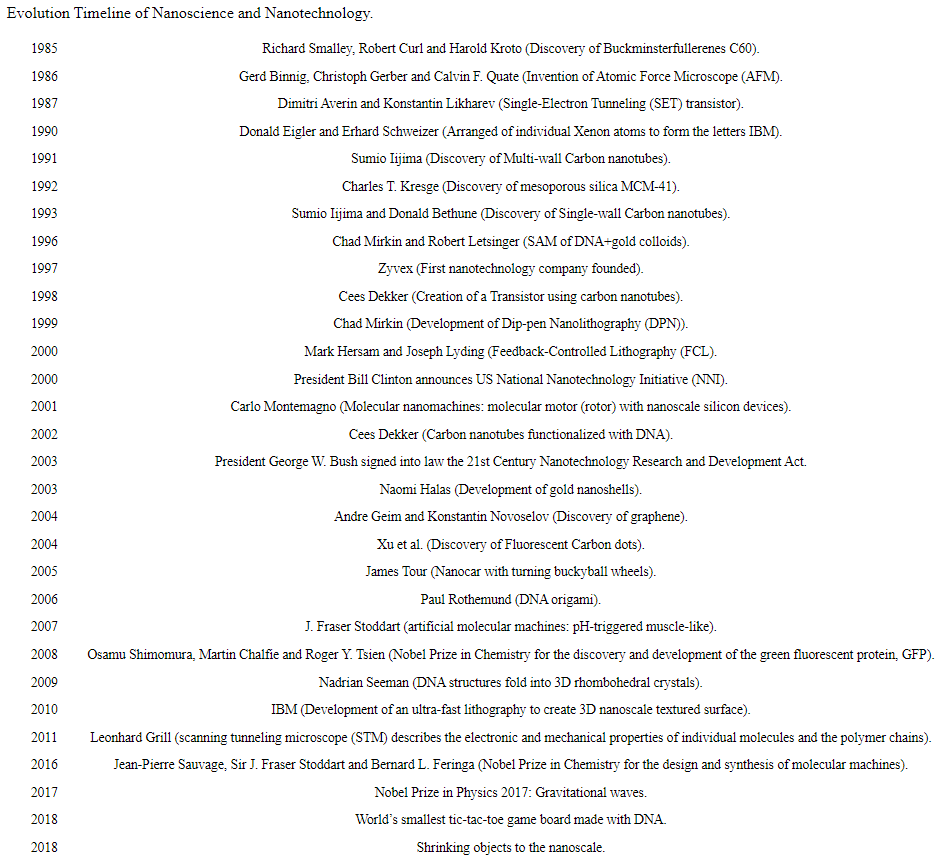
The latter is treated as a failure by those who hold the former view, but I can’t help but be awed by the ridiculously cool things we’ve been able to construct anyway. Jean-Pierre Sauvage, Sir Fraser Stoddart and Bernard Feringa won the Nobel Prize in Chemistry for the design and synthesis of molecular machines, so even if we haven’t made the Feynman machines yet, there’s been some progress.
This has been more adulatory of something I hadn’t realised had gone from vague mentions on terrible potential consequences and high praise in hard science fiction, to boring reality. May our future failures be as bold and bright!

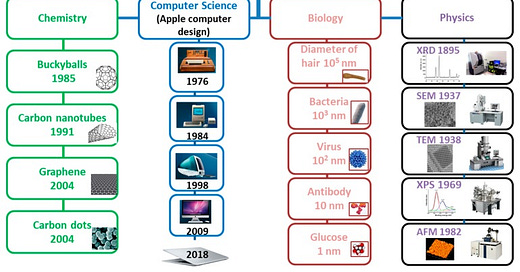


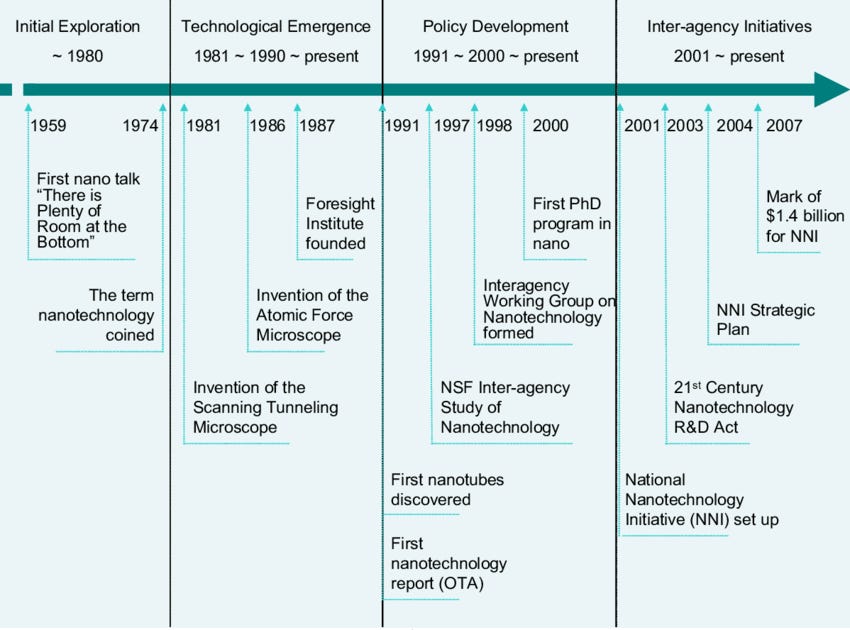
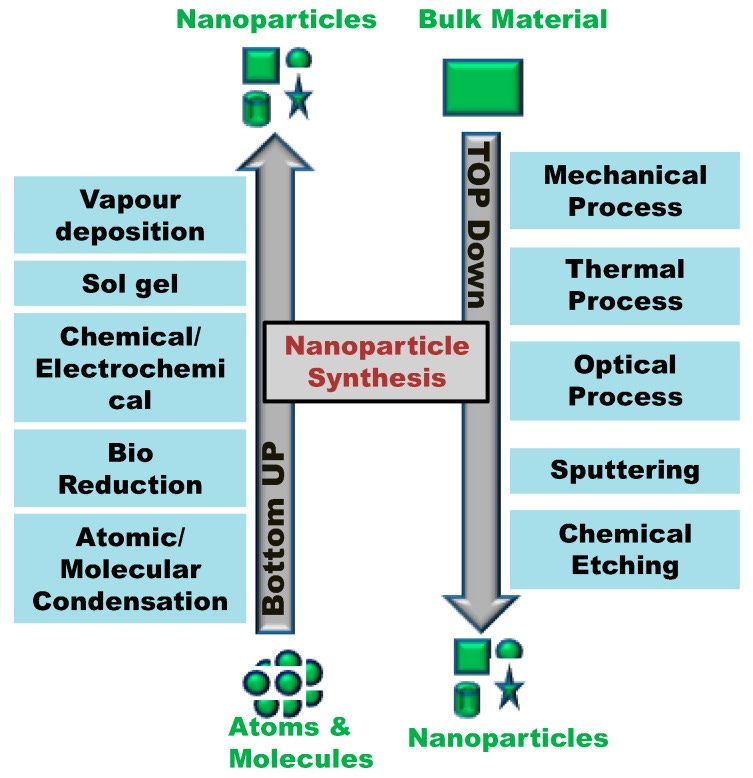


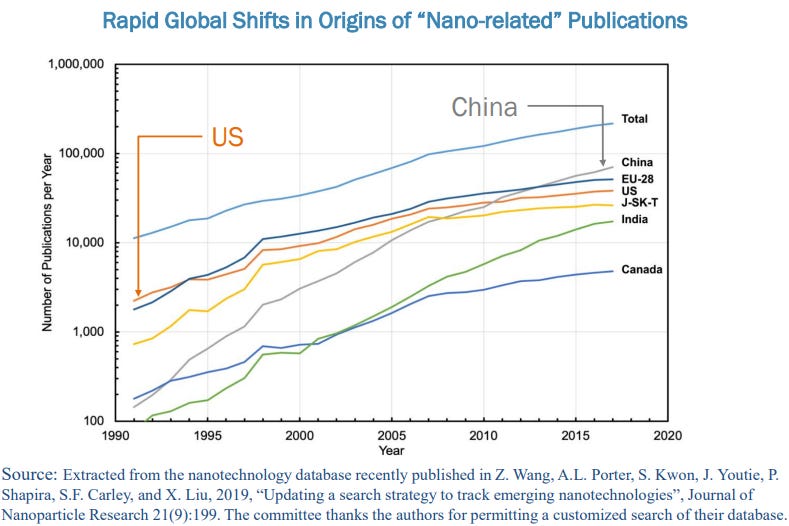

Drexler's website seems to be down, I hope it's just a temporary glitch.
Ever since reading Drexler's Engines of Creation in 1989, it's been clear to me that self-replicating nanotechnogy will be more important than all past inventions combined, more productive than all prior ideas, capital and labor.
What happened? The open work of Drexler, Merkle and the rest was sabotaged by Cabal (call them what you will, the agents of the pervasive matrix of malicious mediocrity). It may have continued in secret, but I doubt they got far. Such inferior people are incapable of understanding what even a little leak of genius can lead to, for instance the seed of Merkle trees sprouting into the whole crypto ecosystem. But it's impossible to more than delay the arrival of nanotechnoogy, no matter how Cabal blights the lives of our Promethians.
We should hold government investment in science to a higher standard than it just provided some value. We should always bear in mind alternatives uses of the capital and the intellect used up in achieving any result. Nobody would be happy if their fund manager told them they should be happy with a 2% return when the market was giving 10%.